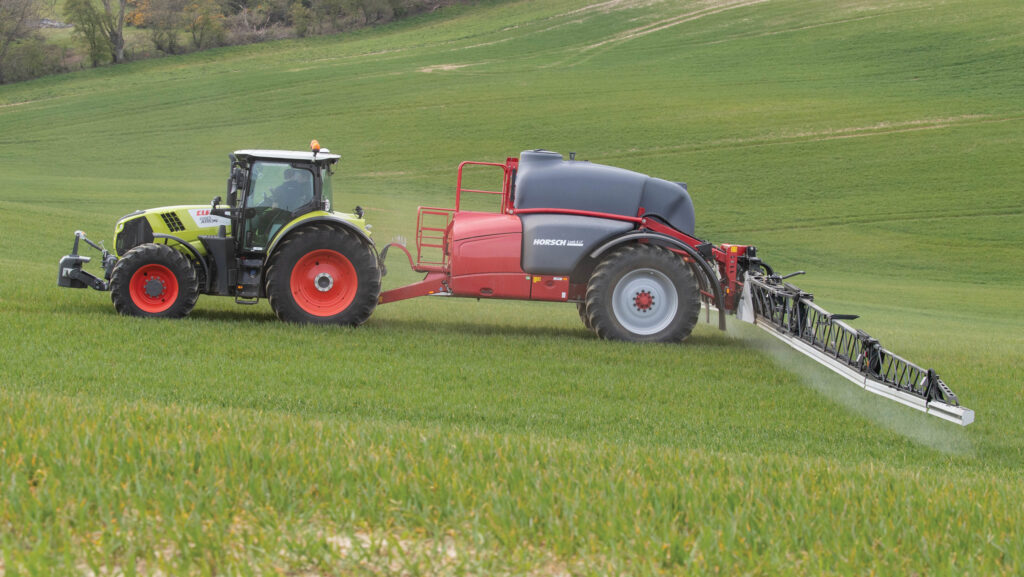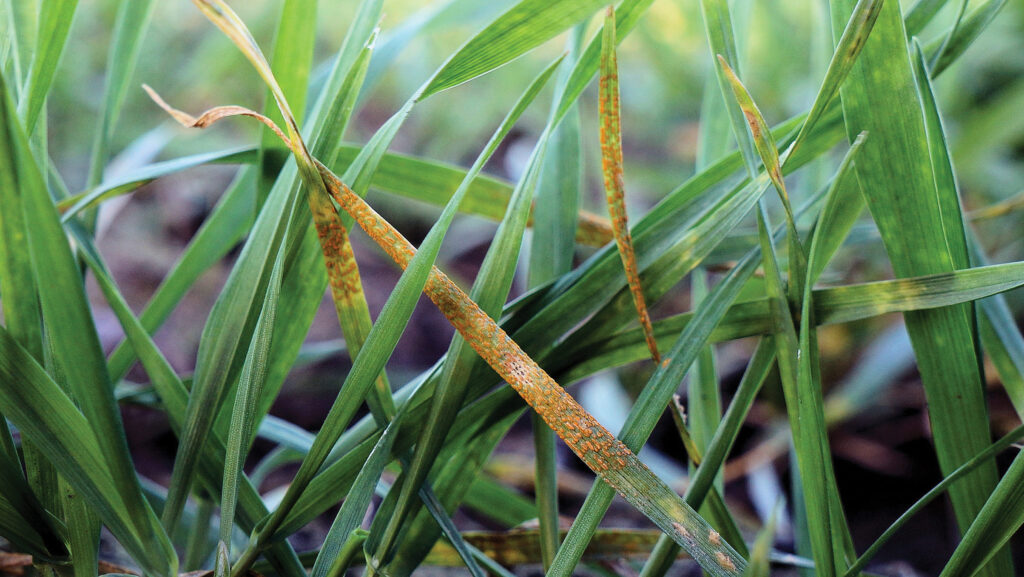Expert tips for T1 fungicide strategies in rain-battered wheat
 © Tim Scrivener
© Tim Scrivener Weeks of rain and higher-than-normal spring temperatures are creating challenges for T1 fungicide plans, with growers advised to be guided by drilling date and variety.
In such a testing season, there are also disrupted fieldwork plans, disappointing commodity prices and a smaller national wheat crop to consider, say agronomists, who recognise that farm budgets are tight.
See also: Advice on getting the most from Dawsum winter wheat
Like last year, there is plenty of septoria in well-established crops, while T0 spraying opportunities have been few and far between – putting more demands on the T1 timing than in a dry spring.
According to senior consultant Chloe Morgan of Adas, it’s a high-pressure start to the season, with uneven crops another factor to consider as plans are made.
“The T1 target is leaf three, so depending on the crop you have, the spray window is from mid-April onwards.”
Chemistry
- Ascra Bixafen + fluopyram + prothioconazole
- Elatus Era Benzovindiflupyr (Solatenol)+ prothioconazole
- Revystar Fluxapyroxad + mefentrifluconazole
- Univoq Fenpicoxamid (Inatreq) + prothioconazole
- Iblon Isoflucypram (sold in a twin pack with prothiocoanazole as Vimoy)
Septoria threat
As in most years, septoria is sitting on lower leaves in crops quite happily, reports Chris Bean, technical director of Zantra.
“There’s also significant yellow rust in some varieties and we’ve even been able to find brown rust already.”
Given the backlog of fieldwork and competing demands on sprayers, tank mixes need to be given careful thought and rules adhered to as spraying gets under way, he adds.
“If there hasn’t been a chance to apply a T0, you need to work out what you are going to do with plant growth regulators and micronutrition, how to deal with grassweeds, as well as how you are going to approach T1.
“Putting a lot in the tank at one time isn’t ideal.”
Variety choice
The widespread adoption of more resistant varieties has put more focus on T1, as well as giving a bit more flexibility with spray timing, believes Indigro’s Damian McAuley, an independent agronomist and member of the Association of Independent Crop Consultants.
“Varieties such as Palladium, Champion and Mayflower are clean of early season rusts and mildew, so might not need a T0, easing pressure on farm workloads.”
Good septoria resistance in these varieties also means the T1 spray needn’t be rushed and can be well timed to leaf 3 fully emerged.
However, the temptation to drill them a bit earlier in the autumn does increase the septoria risk, especially in such a wet and mild year.
“In these conditions, the T1 spray becomes every bit as important as the T2 and needs to be well-timed,” he says.
“That’s because septoria control is difficult; there’s very little curative activity available from fungicides.”
Yield potential
As far as T1 fungicide costs are concerned, it makes little difference whether crops have high or low yield potential, adds Damian.
“There are more savings to be made by reducing fertiliser on the less-promising crops than there are by cutting back on fungicides at this stage of the season.
“Of course, there is a balance to achieve between return on investment and any yield loss.
“But don’t pull back massively; septoria doesn’t care about your fungicide budget, so be mindful if you’re tempted to cut back.”
That opportunity may come at T2, if the weather dries up, he points out.
The exception is very late-drilled wheat, which he will treat as a spring crop.
“It hasn’t been exposed to disease in the same way, so the focus is on rusts and mildew and the spend will be less.”
Later-drilled wheats
There is plenty of independent research to show that the hierarchy of the leaf canopy changes in later-drilled wheat crops, reports Zantra’s Chris Bean.
As the flag leaves are smaller, there’s a greater yield contribution from leaf two, three and four, so keeping the canopy green is important.
“A decent T1 and T2 will pay off in most situations, even if they are still looking rather sad in cold, wet soils,” he says.
“There won’t have been the need – or possibly time – for a T0, so that helps with budget decisions. However, keep a watch for mildew and yellow rust.”
Chloe Morgan of Adas says late-drilled wheat will be under less septoria pressure than crops that were drilled earlier, making yellow rust and mildew the two diseases to look out for.
“These crops may have a lower yield potential, but we don’t want to lose any more,” she adds. “They are driven by daylight hours and temperature, so will be moving on now.”
The timing of yellow rust control is more important than the product, she adds. “Keeping your spray intervals tight matters with a disease that cycles so quickly.”
Product choice
If unsettled conditions continue, the case for a £40/ha+ T1 spray becomes stronger, with product choice and rates being fine-tuned accordingly, he acknowledges.
“It will be easier to justify using the new Bayer product Iblon if it keeps raining and risk carries on rising. On more susceptible varieties, it may even be worth switching to Univoq at T1.”
Revystar is another good option, he notes, although some will be holding it back for the T2 application.
Otherwise, Damian favours an Ascra-type product for T1 and will make the decision on rates and whether to include the multisite folpet nearer the time. “If we are facing a very high-pressure situation then I will add in folpet.”
Yellow rust concerns
Chris agrees that much depends on the next two weeks and if the weather patterns change to drier, settled conditions.
“Moving towards T1 with no T0 on is a concern with yellow rust, as it’s been popping up everywhere.
Adult plant resistance should kick in on some of the affected varieties, but relying on that is a test of nerves.
“Of course, if it stays showery, septoria will need serious attention too.”
Fungicide products with good yellow rust activity, such as Elatus Era, have performed well in the T1 slot, he says.
The new option for this year, Iblon, will be of interest for both its rust and septoria activity, he predicts.
“At 1 litre/ha, it will be one of the more expensive options, but it’s important not to compromise control by reducing rates too far.”
Growers who are tempted to reduce Iblon rates might be better off switching to Elatus Era or Ascra, he suggests, while Univoq is an option at either T1 or T2.
“It has more kick-back and we used it very effectively at T1 last year, when growers were up against it.”

© Blackthorn Arable
Eyespot
Eyespot is always a consideration at T1, says Chloe, who points out that disease development is faster in mild, wet conditions and early sown crops are more at risk.
The azoles offer activity against the disease, she adds. “They will be in T1 sprays anyway, but having the appropriate dose is important.”
Budgets
As far as fungicide budgets are concerned, growers are unlikely to get away with much less than £100/ha this year, acknowledges Zantra’s Chris Bean.
“No one wants to overspend, but better crops, especially those destined for milling, are probably worth spending £125-£140/ha.
“It all depends on what situation they are in. Remember that we only have about 60% of the intended wheat in the ground.”
SDHI fungicide
Syngenta’s new fungicide, which has delivered substantial yield gains in wheat and barley trials, has received approval for use in Great Britain.
The active is claimed to be extremely effective against septoria in wheat, and net blotch and ramularia in barley.

